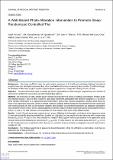Files in this item
A web-based photo-alteration intervention to promote sleep : randomized controlled trial
Item metadata
| dc.contributor.author | Perucho, Isabel | |
| dc.contributor.author | Vijayakumar, Kamalakannan M. | |
| dc.contributor.author | Talamas, Sean | |
| dc.contributor.author | Chee, Michael Wei-Lang | |
| dc.contributor.author | Perrett, David I. | |
| dc.contributor.author | Liu, Jean | |
| dc.date.accessioned | 2019-09-30T09:30:01Z | |
| dc.date.available | 2019-09-30T09:30:01Z | |
| dc.date.issued | 2019-09-26 | |
| dc.identifier | 260281606 | |
| dc.identifier | 3b998b87-e635-43e9-a31e-620dc0747ffc | |
| dc.identifier | 000487968700001 | |
| dc.identifier | 85072847353 | |
| dc.identifier.citation | Perucho , I , Vijayakumar , K M , Talamas , S , Chee , M W-L , Perrett , D I & Liu , J 2019 , ' A web-based photo-alteration intervention to promote sleep : randomized controlled trial ' , JMIR , vol. 21 , no. 9 , e12500 . https://doi.org/10.2196/12500 | en |
| dc.identifier.issn | 1439-4456 | |
| dc.identifier.other | ORCID: /0000-0002-6025-0939/work/64360978 | |
| dc.identifier.uri | https://hdl.handle.net/10023/18579 | |
| dc.description | This work was supported by grants awarded to JCJL by the Singapore Ministry of Education (start-up grant number: R-607-264-057-121 and AcRF Tier 1: IG15-B052). | en |
| dc.description.abstract | Background: Receiving insufficient sleep has wide-ranging consequences for health and well-being. Although educational programs have been developed to promote sleep, these have had limited success in extending sleep duration. To address this gap, we developed a web-based program emphasizing how physical appearances change with varying amounts of sleep. Objective: The aims of this study were to evaluate: (1) whether participants can detect changes in appearances as a function of sleep, and (2) whether this intervention can alter habitual sleep patterns. Methods: We conducted a 5-week, parallel-group, randomized controlled trial amongst 70 habitual short sleepers (healthy adults who reported having <7 hours of sleep routinely). Upon study enrolment, participants were randomly assigned (1:1) to receive either standard information or an appearance-based intervention. Both groups received educational materials about sleep, but those in the appearance group also viewed a website containing digitally-edited photographs that showed how they would look with varying amounts of sleep. As outcome variables, sleep duration was monitored objectively via actigraphy (at baseline, and at post-intervention weeks 1 and 4), and participants completed a measure of sleep hygiene (at baseline, and at post-intervention weeks 2, 4, and 5). For each outcome, we ran intention-to-treat analyses using linear mixed-effects models. Results: In total, 35 participants were assigned to each group. Validating the intervention, participants in the appearance group: (i) were able to identify what they looked like at baseline, and (ii) judged that they would look more attractive with a longer sleep duration (t(26) = 10.35, P < .001). In turn, this translated to changes in sleep hygiene: whereas participants in the appearance group showed improvements following the intervention (F(1,107.99) = 9.05, P = .003), those in the information group did not (F(1,84.7) = 0.19, P = .66). Finally, there was no significant effect of group nor interaction of group and time on actigraphy-measured sleep duration (smallest P = .26). Conclusions: Our findings suggest that an appearance-based intervention – while not sufficient as a standalone – could have an adjunctive role in sleep promotion. | |
| dc.format.extent | 11 | |
| dc.format.extent | 896557 | |
| dc.language.iso | eng | |
| dc.relation.ispartof | JMIR | en |
| dc.subject | Sleep | en |
| dc.subject | Public health | en |
| dc.subject | Physical appearance | en |
| dc.subject | Outward appearance | en |
| dc.subject | BF Psychology | en |
| dc.subject | NDAS | en |
| dc.subject | SDG 3 - Good Health and Well-being | en |
| dc.subject.lcc | BF | en |
| dc.title | A web-based photo-alteration intervention to promote sleep : randomized controlled trial | en |
| dc.type | Journal article | en |
| dc.contributor.institution | University of St Andrews. Institute of Behavioural and Neural Sciences | en |
| dc.contributor.institution | University of St Andrews. Centre for Social Learning & Cognitive Evolution | en |
| dc.contributor.institution | University of St Andrews. School of Psychology and Neuroscience | en |
| dc.identifier.doi | 10.2196/12500 | |
| dc.description.status | Peer reviewed | en |
| dc.date.embargoedUntil | 2019-09-26 |
This item appears in the following Collection(s)
Items in the St Andrews Research Repository are protected by copyright, with all rights reserved, unless otherwise indicated.

